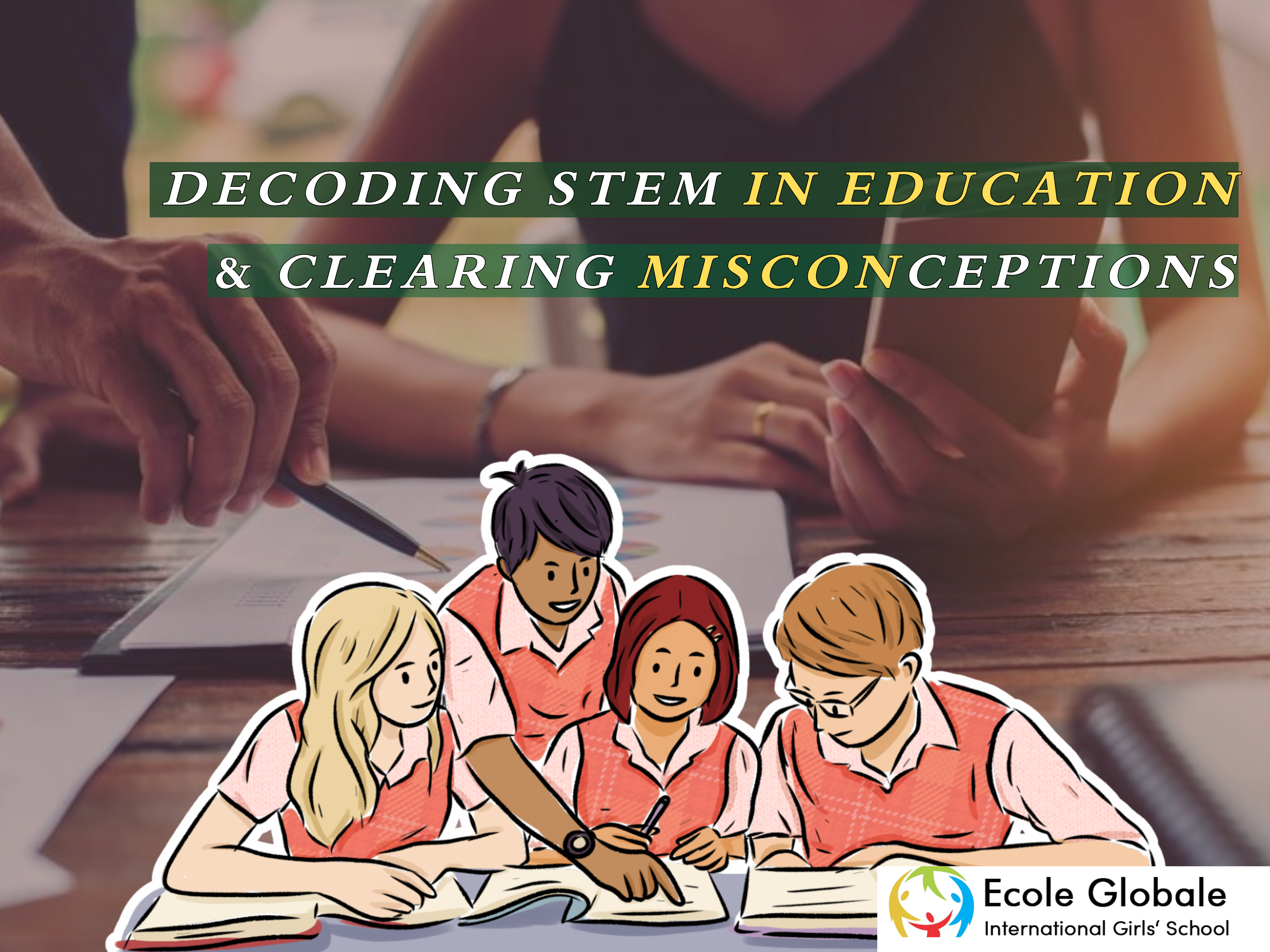STEM in education (Science, Technology, Engineering, Mathematics) is more than just an educational acronym—it’s a learning philosophy that promotes problem-solving through hands-on applications. Many believe STEM is just about advanced subjects like robotics and coding, but it actually emphasizes everyday thinking and problem-solving.
Integrated with creativity in STEAM (adding “Arts”), it plays a pivotal role in fostering critical thinking, especially under frameworks like NEP 2020. This guide debunks common misconceptions and emphasizes its importance in developing well-rounded, curious learners.
Understanding STEM Beyond the Acronym

At its heart, STEM is an interdisciplinary approach combining science, technology, engineering, and math in practical learning. Instead of just focusing on theory, it encourages students to collaborate, innovate, and solve real-world problems using the knowledge they gain. This method is crucial in building future innovators, as it teaches students to think critically and apply their learning beyond textbooks.
The Growth of STEM in Education

STEM in education has gained widespread attention, especially in recent years, due to the rise in technological advancements. With more jobs requiring STEM skills, integrating this educational approach prepares students for the challenges of tomorrow. However, many still confuse STEM with pure science or complex coding. In reality, it’s about curiosity and learning from everyday experiences.
The Addition of Arts to STEM: STEAM

A common extension of STEM is STEAM, where “A” stands for Art. The inclusion of arts fosters creativity, broadens the imagination, and promotes a more holistic approach to problem-solving. By adding art, STEM transforms into a more inclusive model, allowing students to think outside the box while still retaining analytical skills. For instance, STEAM helps in data visualization, which requires both technical and creative skills.
Misconceptions About STEM

One of the biggest misconceptions is that STEM is only for future engineers or scientists. This belief limits its true purpose. STEM is for everyone, as it helps develop critical thinking, problem-solving, and communication skills that are essential in all fields. The approach is far from being just about robotics or calculus—it’s about thinking, observing, and learning from the world around you.
Practical Applications of STEM in Education

STEM is increasingly becoming a part of modern educational reforms, including India’s National Education Policy (NEP) 2020. NEP encourages a multidisciplinary approach, aligning perfectly with STEM, where students engage in a balance of theoretical knowledge and practical experience. STEM encourages students to be hands-on, leading to a better understanding of concepts and improving retention. Additionally, educators and parents play a crucial role in promoting curiosity. It’s not about providing sophisticated tools but encouraging children to explore their environment and ask questions.
Encouraging STEM at Home

Parents can help foster a love for STEM by engaging their children in activities that promote curiosity and discovery. Simple practices like nature walks, museum visits, or even discussing how everyday objects work can stimulate a child’s interest in STEM topics. Encouraging questions and allowing children the freedom to explore their interests are key aspects of early STEM learning. STEM in education doesn’t require fancy gadgets or complex programming tools—it’s about building curiosity and problem-solving skills from a young age.
Benefits of STEM Learning
- Develops Critical Thinking: STEM students are encouraged to ask questions and think critically, fostering independent thought.
- Boosts Problem-Solving Skills: Tackling real-world problems in STEM teaches students to come up with creative and efficient solutions.
- Encourages Collaboration: STEM learning often involves teamwork, which helps students improve their communication and collaboration skills.
- Prepares for Future Jobs: As industries continue to innovate, many future jobs will require STEM-related skills.
- Instills Curiosity: STEM encourages a natural curiosity in students, which can lead to lifelong learning and exploration.
How Schools Can Incorporate STEM Effectively

Schools in dehradun need to create an environment where STEM can thrive. Rather than treating STEM subjects as separate, educators should aim for an integrated approach where students can see the connections between different fields. For example, students could work on projects that combine engineering with math and science, solving real-life problems that make learning more engaging. Schools can also partner with industries to provide students with hands-on experience and exposure to real-world applications of STEM.
Conclusion: The Future of STEM in Education
STEM in education is vital for developing the thinkers, creators, and problem-solvers of tomorrow. It equips students with not just knowledge, but the skills and mindset to apply what they learn to real-world situations. The integration of arts in STEAM provides a well-rounded approach, blending creativity with technical knowledge. Ultimately, encouraging curiosity and providing practical experiences are the cornerstones of effective STEM in education.
By understanding the true essence of STEM and debunking common misconceptions, educators and parents can help students harness the full potential of this educational approach. STEM is not about memorizing formulas or mastering complex technologies; it’s about nurturing curiosity, promoting critical thinking, and preparing students for a future where they can confidently face challenges and innovate.
FREQUENTLY ASKED QUESTION
1. What is STEM in education?
STEM stands for Science, Technology, Engineering, and Mathematics. It is an interdisciplinary approach to learning that focuses on hands-on problem-solving and critical thinking.
2. How is STEM different from traditional education?
Unlike traditional education, which often focuses on theoretical learning, STEM emphasizes practical applications, collaboration, and innovation to solve real-world problems.
3. What is STEAM, and how is it different from STEM?
STEAM includes an additional component—Arts—into STEM education. It integrates creativity and design thinking, helping students develop a more holistic approach to problem-solving.
4. Is STEM only for students interested in science and technology?
No, STEM is for everyone. It helps develop critical thinking, problem-solving, and communication skills that are essential across all careers and fields of study.
5. How does STEM align with India’s National Education Policy (NEP) 2020?
NEP 2020 promotes a multidisciplinary approach to education, which aligns with STEM by encouraging experiential learning, problem-solving, and hands-on applications in classrooms.









